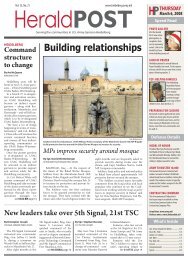Herald Post 2009-10-01.pdf
Herald Post 2009-10-01.pdf
Herald Post 2009-10-01.pdf
You also want an ePaper? Increase the reach of your titles
YUMPU automatically turns print PDFs into web optimized ePapers that Google loves.
HP<br />
Thursday, Oct. 1, <strong>2009</strong><br />
LEISURE<br />
17<br />
Historic Regensburg<br />
This small Bavarian city invites<br />
you to take a trip into the past<br />
By Lou Stagger<br />
BAVARIAN NEWS<br />
With a history spanning nearly 2000<br />
years, the grand old city of Regensburg offers<br />
a lot to see.<br />
Situated at the confluence of the Regen<br />
and Danube rivers on the most northerly<br />
bend of the Danube, Regensburg started<br />
its written history during the time of the<br />
Romans.<br />
The Romans were able to use the rivers<br />
as defensive points but were never able to<br />
hold the territory north of the river. They<br />
settled in by creating the Castra Regina, fort<br />
by the Regen River, and eventually it became<br />
known as Regensburg.<br />
In 1135 a stone bridge was started across<br />
the Danube. It took 11 years to complete.<br />
The Crusader Knights for the second and<br />
third Crusades crossed the bridge on their<br />
way to the Holy Lands. The bridge, “Steinerne<br />
Brücke” opened up the northern European<br />
cities to trade with the powerhouse of<br />
traders: Venice, Italy.<br />
Regensburg gained well from this cross<br />
traffic. Goods passed through Regensburg as<br />
it developed its reputation for goldsmithing<br />
and making fabrics.<br />
Also Christianity has been a great part of<br />
Regensburg’s history. St. Boniface set up a<br />
Bishopric there in the year 739 and Regensburg<br />
opened up the eastern European<br />
borders to Christianity.<br />
In 845, more than a dozen Bohemian<br />
princes came here to be baptized.<br />
Regensburg became the head diocese for<br />
the diocese of Prague. During the years 1275<br />
to 1634 a great Gothic cathedral was built.<br />
The towers were added in 1869. The St.<br />
Peter Cathedral, or Regensburger Dom, is<br />
the greatest example of German Gothic style<br />
building in Bavaria.<br />
The cathedral is a “must see” while<br />
visiting. It’s also the home of the German<br />
equivalent to the Vienna Boys Choir: the<br />
Sparrows.<br />
Many works of art and artifacts are<br />
housed within the cathedral and adjoining<br />
museums.<br />
Within the relatively small area of the Altstadt,<br />
or old town, you can see at least five<br />
different styles of church architecture.<br />
The City Museum of Regensburg is a<br />
remarkably complete display of early history<br />
from the Roman and pre-Roman times to<br />
the height of Regensburg’s days as the capital<br />
of Bavaria through the time of the Holy<br />
Roman Empire.<br />
On the south end of town is the former<br />
Abbey of St. Emmeram. It’s now the Palace<br />
of Thurn and Taxis, whose rise to royal status<br />
was remarkable. The princess still lives<br />
here with her two children.<br />
Tours are offered in the older sections of<br />
the palace which is larger than Buckingham<br />
Palace in England. Here you can listen to an<br />
English audio guide to learn the secret of<br />
their rise from common public service and<br />
be surprised at how America wasn’t the first<br />
to use this technique.<br />
If you want a small city with a huge history,<br />
put Regensburg on your list of places<br />
to see while you are stationed in Germany.<br />
You may just find it charming and delightful.<br />
Photos by Bill Barber<br />
The city’s Gothic Cathedral of St. Peter was built from 1274-1520 on the site<br />
of a large Romanesque church, some portions of which are integrated into<br />
the current structure. The spires and upper portions of the towers are 19th<br />
Century additions. When the cathedral was cleaned, it became possible to<br />
see two types of stone in the façade: a cream-colored limestone and a softer<br />
green sandstone that was used for repairs and additions in the 18th century.<br />
The green blocks are being replaced gradually with limestone from the Czech<br />
Republic that matches the original material.<br />
The Walhalla is considered the most important of all works commissioned by King Ludwig<br />
l of Bavaria (1825-48). It was completed in 1842 and it commemorates great figures from<br />
German history. “Walhalla” means “hall of the dead.” German or Germanic personalities<br />
may be considered for a place in this hall of fame 20 years after their death at the earliest.<br />
On its inauguration Oct. 18, 1842, there were 96 busts and 64 plaques. 30 busts have been<br />
added since.<br />
(Left) The Steinerne<br />
Brücke has<br />
15 arches and runs<br />
nearly 750 meters<br />
from the Altstadt<br />
to Stadtamhof. At<br />
one time, the Steinerne<br />
Brücke was an<br />
important crossing<br />
point along the<br />
main trade route<br />
between Venice<br />
and Northern Europe.
















